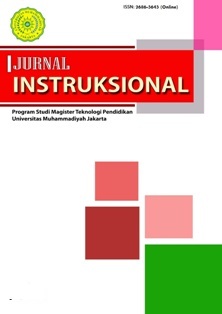MODEL PEMBELAJARAN SISTEM BASIS DATA BERBASIS COMPUTER ASSISTED INSTRUCTION
Main Article Content
Abstract
Article Details
References
Darmawan, D. 2011. Teknologi Pembelajaran (2nd ed.). Rosada Karya.
Isni, W., & Setya, Chendra, W. 2016. Pengembangan Model Pembelajaran Computer Assisted Instruction ( CAI ) Tipe Tutorial Dengan Aplikasi Lectora Inspire Pada Mata Pelajaran Sistem Operasi Kelas X SMK. It-Edu, 1(2), 65–69.
Jasmy, M., Rahman, A., Arif, M., Ismail, H., & Nasir, M. 2014. Development and Evaluation of the Effectiveness of Computer-Assisted Physics Instruction. 7(13), 14–22.
Mario G, P., & Oscar, D. 2000. Advanced Database Technology and Design (1st ed.). Artech House.
Ramez, E., & Shamkant B, N. 2016. Fundamentals of Database systems. Seventh Edition (Seventh). Pearson Higher Education.
Simarmata, J., Limbong, T., Katolik, U., Thomas, S., Utara, S., Sriadhi, S., Medan, U. N., & Tambunan, A. 2018. Learning Application of Multimedia-Based-Computer Network Using Learning Application of MultimediaBasedComputer Network Using Computer Assisted Instruction Method. August, 8–12.
Suleman Q., Hussain, Din M. & Iqbal K. 2017. Effects of Computer-Assisted Instruction (CAI) on Students’ Academic Achievement in Physics at Secondary Level Effects of Computer-Assisted Instruction ( CAI ) on Students ’ Academic Achievement in Physics at Secondary Level. Computer Engineering and Intelligent Systens, 8 No.7(October), 9–17
Wibawa, B., Mahdiyah, & Afgani, J. 2014. Metode Penelitian Pendidikan. Universitas Terbuka. Widoyoko, S. E. P. 2019. Evaluasi Program Pembelajaran (Panduan Praktis Bagi Pendididik Dan Calon Pendidik) (X). Pustaka Pelajar.
Yuelan, L., Yiwei, L., Yuyan, H., & Yuefan, L. 2011. Study on teaching methods of database application courses. Procedia Engineering, 15, 5425–54

